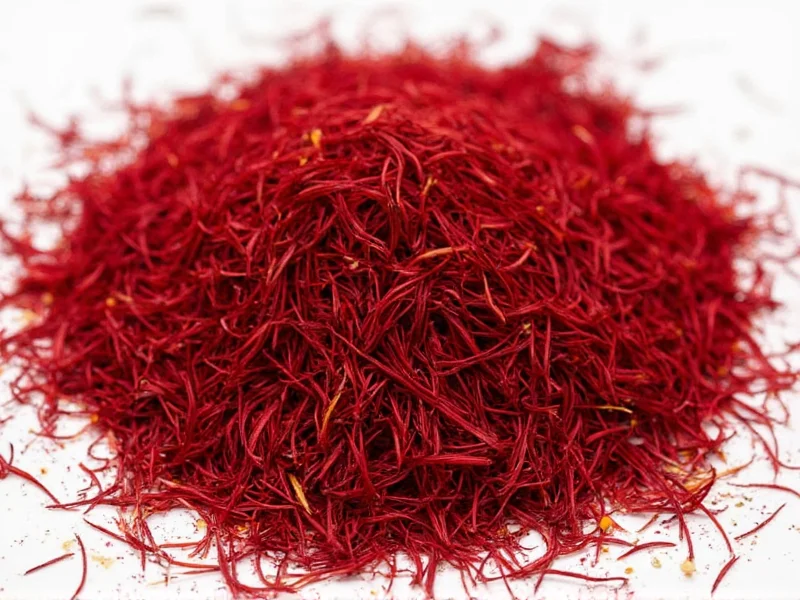Understanding saffron pricing requires recognizing why this spice commands such premium rates. Saffron remains the world's most expensive spice by weight due to its labor-intensive harvesting process—each delicate crimson stigma must be hand-picked from crocus flowers, with approximately 75,000 blossoms needed to produce just one pound of dried saffron.
Factors That Determine Saffron Price Per Pound
Saffron pricing isn't arbitrary—several critical factors influence the final cost you'll pay for a pound of this precious spice. These elements create significant price variations across the global market.
Grade and Quality Classification
The International Organization for Standardization (ISO) established quality grades for saffron based on crocin (color), picrocrocin (taste), and safranal (aroma) content. Higher grades command premium prices:
| ISO Grade | Crocin Level | Typical Price Per Pound | Characteristics |
|---|---|---|---|
| Grade I (Super Negin) | ≥190 | $4,500-$8,000 | Long, deep red threads; highest potency; minimal yellow styles |
| Grade II (Sargol) | 150-189 | $3,500-$5,500 | Red threads only; good color strength; popular commercial grade |
| Grade III (Pushal) | 110-149 | $2,500-$4,000 | Contains some yellow styles; moderate color strength |
| Grade IV (Bunch) | <110 | $1,800-$3,000 | Whole threads with significant yellow styles; lowest potency |
Geographical Origin Impact
Where saffron is grown dramatically affects its price per pound. Iran dominates global production (accounting for approximately 90% of worldwide supply), but other regions produce distinctive varieties:
- Iranian saffron: Most common commercially available saffron; prices range from $2,500-$5,000 per pound for premium grades
- Spanish saffron: Often marketed as premium product; typically $3,500-$6,000 per pound despite similar quality to Iranian counterparts
- Kashmiri saffron: Rare and highly prized; commands $5,000-$8,000+ per pound due to limited production and distinctive flavor profile
- Greek saffron: Protected designation of origin; priced around $4,000-$5,500 per pound
Market Dynamics and Seasonal Fluctuations
Saffron prices experience notable fluctuations based on several market factors:
- Harvest yields: Drought conditions in major producing regions (like Iran) can reduce supply and increase prices by 20-30% in poor harvest years
- Currency exchange rates: As most saffron trades in euros or dollars while production costs are in local currencies, exchange rates significantly impact final pricing
- Global demand: Rising popularity in culinary applications and emerging research into saffron's health benefits have increased demand by approximately 5% annually
- Import regulations: Strict quality controls in destination markets can affect availability and pricing
What Determines Value When Buying Saffron by the Pound
Purchasing saffron in pound quantities typically indicates commercial use—whether for restaurants, food manufacturing, or resale. Understanding value requires looking beyond the sticker price.
Actual Stigma Content vs. Fillers
Lower-priced saffron often contains significant amounts of yellow style (the non-pigmented part of the stigma), which adds weight but minimal flavor or color. Premium saffron consists almost entirely of red stigma. When evaluating current saffron market price per pound, examine the actual red thread content.
Testing Methods for Quality Verification
Professional buyers use several methods to verify saffron quality before purchasing by the pound:
- ISO 3632 testing: Laboratory analysis measuring crocin, picrocrocin, and safranal levels
- Water test: Genuine saffron gradually releases yellow-orange color in warm water (not immediate red dye)
- Smell test: High-quality saffron has a distinctive hay-like, floral aroma
- Visual inspection: Look for uniform deep red color without excessive broken threads or yellow styles
Common Misconceptions About Saffron Pricing
Several myths persist about saffron costs that affect buyer expectations when researching how much is a pound of premium saffron.
"Spanish Saffron Is Always Superior" Myth
While Spanish saffron carries premium branding, Iranian saffron often matches or exceeds it in quality testing. The price difference frequently reflects marketing rather than measurable quality differences. Many restaurants pay premium prices for Spanish-labeled saffron without realizing they're purchasing Iranian saffron repackaged in Spain.
"Lower Price Means Better Value" Fallacy
When evaluating wholesale saffron price per pound, remember that extremely low prices usually indicate compromised quality. Saffron priced below $2,000 per pound typically contains significant fillers or is of inferior grade. The labor costs alone for harvesting make genuinely low-cost saffron impossible.
Practical Buying Advice for Commercial Purchases
If you're considering purchasing saffron by the pound for business purposes, follow these evidence-based recommendations:
- Request ISO 3632 certification: Reputable suppliers provide laboratory test results verifying quality grade
- Start with small test batches: Before committing to pound quantities, test smaller amounts to verify quality meets your requirements
- Consider moisture content: Saffron should have 8-12% moisture; higher levels add unnecessary weight
- Verify packaging standards: Properly packaged saffron uses airtight, light-resistant containers with oxygen absorbers
- Build direct supplier relationships: Cutting out middlemen can reduce costs while ensuring traceability
Future Price Trends to Watch
Several factors may influence current market rate for saffron per pound in coming years:
- Climate change impacts: Increasing drought frequency in traditional growing regions could reduce yields and increase prices
- Expanded cultivation: New saffron farming in countries like India, Greece, and even the United States may stabilize prices through increased supply
- Research developments: Studies confirming saffron's health benefits could dramatically increase demand beyond current culinary uses
- Technology improvements: More efficient harvesting methods could eventually reduce labor costs, though significant breakthroughs remain distant
Conclusion: Understanding True Saffron Value
When evaluating how much does a pound of saffron cost, remember that price alone doesn't determine value. The most economical choice considers potency, shelf life, and actual usable quantity rather than just the initial purchase price. High-quality saffron used properly delivers exceptional flavor and color with minimal quantity—typically just 0.02-0.03 ounces per pound of food—making even premium-priced saffron cost-effective in professional applications when used correctly.











 浙公网安备
33010002000092号
浙公网安备
33010002000092号 浙B2-20120091-4
浙B2-20120091-4